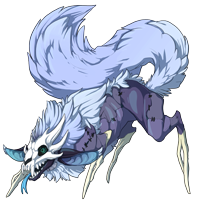

HMSTerror
(#82264404)
Level 1 Undertide
Click or tap to view this dragon in Predict Morphology.
Energy: 48/50

Expand the dragon details section.
Collapse the dragon details section.
Personal Style

Ancient dragons cannot wear apparel.
Skin
Scene
Measurements
Length
15.99 m
Wingspan
20.66 m
Weight
3868.15 kg
Genetics
Phthalo
Ribbon (Undertide)
Ribbon (Undertide)
White
Basic
Basic
Metals
Basic
Basic
Hatchday
Breed
Eye Type
Level 1 Undertide
EXP: 0 / 245


STR
5
AGI
9
DEF
5
QCK
8
INT
6
VIT
6
MND
6
Lineage
Parents
Offspring
- HMSWarrior
- HMSGannet
- HMSComet
- HMSPearl
- HMSDilligence
- HMSGrampus
- HMSDoterel
- HMSBounty
- HMSBelvidera
- HMSUnicorn
- HMSCormorant
- HMSReindeer
- HMSFlyingFish
- HMSEndymion
- HMSPyramus
- HMSStVincent
- HMSEdinburgh
- HMSVolage
- HMSExcellent
- HMSRattler
- HMSCalliope
- HMSExcellent
- HMSDido
- HMSPembroke
- HMSAntelope
- HMSPolyphemus
- HMSInvestigator
- HMSShearwater
- HMSEagle
- HMSBeagle
- HMSFury
- HMSAlbion
- HMSGriper
- HMSSolebay
- HMSRattlesnake
- HMSOcean
- HMSShearwater
- HMSPowerful
- HMSRevenge
- HMSDido
- HMSPembroke
- HMSWanderer
- HMSMagnificent
- HMSRattlesnake
- HMSTalavera
- HMSCornwallis
- HMSBelvidera
- HMSGriper
- HMSHecla
Biography
HMS Terror
Vesuvius-class bomb vessel

HMS Terror was a specialised warship and a newly developed bomb vessel constructed for the Royal Navy in 1813. She participated in several battles of the War of 1812, including the Battle of Baltimore with the bombardment of Fort McHenry. She was converted into a polar exploration ship two decades later, and participated in George Back's Arctic expedition of 1836–1837, the successful Ross expedition to the Antarctic of 1839 to 1843, and Sir John Franklin's ill-fated attempt to force the Northwest Passage in 1845, during which she was lost with all hands along with HMS Erebus.
On 12 September 2016, the Arctic Research Foundation announced that the wreck of Terror had been found in Nunavut's Terror Bay, off the southwest coast of King William Island. The wreck was discovered 92 km (57 mi) south of the location where the ship was reported abandoned, and some 50 km (31 mi) from the wreck of HMS Erebus, discovered in 2014.
Before leaving on the Franklin expedition, both Erebus and Terror underwent heavy modifications for the journey. They were both outfitted with steam engines, taken from former London and Greenwich Railway steam locomotives. Rated at 25 hp (19 kW), each could propel its ship at 4 knots (7.4 km/h). The pair of ships became the first Royal Navy ships to have steam-powered engines and screw propellers. Twelve days' supply of coal was carried. Iron plating was added fore and aft on the ships' hulls to make them more resistant to pack ice, and their decks were cross-planked to distribute impact forces. Along with Erebus, Terror was stocked with supplies for their expedition, which included among other items: two tons of tobacco, 8,000 tins of preserves, and 7,560 L (1,660 imp gal; 2,000 US gal) of liquor. Terror's library had 1,200 books, and the ship's berths were heated via ducts that connected them to the stove.
Their voyage to the Arctic was with Sir John Franklin in overall command of the expedition in Erebus, and Terror again under the command of Captain Francis Crozier. The expedition was ordered to gather magnetic data in the Canadian Arctic and complete a crossing of the Northwest Passage, which had already been charted from both the east and west, but never entirely navigated. It was planned to last three years.
The expedition sailed from Greenhithe, Kent, on 19 May 1845, and the ships were last seen entering Baffin Bay in August 1845. The disappearance of the Franklin expedition set off a massive search effort in the Arctic and the broad circumstances of the expedition's fate were revealed during a series of expeditions between 1848 and 1866. Both ships had become icebound and were abandoned by their crews, all of whom died of exposure and starvation while trying to trek overland to Fort Resolution, a Hudson's Bay Company outpost 970 km (600 mi) to the southwest. Subsequent expeditions up until the late 1980s, including autopsies of crew members, revealed that their canned rations may have been tainted by both lead and botulism. Oral reports by local Inuit that some of the crew members resorted to cannibalism were at least somewhat supported by forensic evidence of cut marks on the skeletal remains of crew members found on King William Island during the late 20th century.
Vesuvius-class bomb vessel

HMS Terror was a specialised warship and a newly developed bomb vessel constructed for the Royal Navy in 1813. She participated in several battles of the War of 1812, including the Battle of Baltimore with the bombardment of Fort McHenry. She was converted into a polar exploration ship two decades later, and participated in George Back's Arctic expedition of 1836–1837, the successful Ross expedition to the Antarctic of 1839 to 1843, and Sir John Franklin's ill-fated attempt to force the Northwest Passage in 1845, during which she was lost with all hands along with HMS Erebus.
On 12 September 2016, the Arctic Research Foundation announced that the wreck of Terror had been found in Nunavut's Terror Bay, off the southwest coast of King William Island. The wreck was discovered 92 km (57 mi) south of the location where the ship was reported abandoned, and some 50 km (31 mi) from the wreck of HMS Erebus, discovered in 2014.
Before leaving on the Franklin expedition, both Erebus and Terror underwent heavy modifications for the journey. They were both outfitted with steam engines, taken from former London and Greenwich Railway steam locomotives. Rated at 25 hp (19 kW), each could propel its ship at 4 knots (7.4 km/h). The pair of ships became the first Royal Navy ships to have steam-powered engines and screw propellers. Twelve days' supply of coal was carried. Iron plating was added fore and aft on the ships' hulls to make them more resistant to pack ice, and their decks were cross-planked to distribute impact forces. Along with Erebus, Terror was stocked with supplies for their expedition, which included among other items: two tons of tobacco, 8,000 tins of preserves, and 7,560 L (1,660 imp gal; 2,000 US gal) of liquor. Terror's library had 1,200 books, and the ship's berths were heated via ducts that connected them to the stove.
Their voyage to the Arctic was with Sir John Franklin in overall command of the expedition in Erebus, and Terror again under the command of Captain Francis Crozier. The expedition was ordered to gather magnetic data in the Canadian Arctic and complete a crossing of the Northwest Passage, which had already been charted from both the east and west, but never entirely navigated. It was planned to last three years.
The expedition sailed from Greenhithe, Kent, on 19 May 1845, and the ships were last seen entering Baffin Bay in August 1845. The disappearance of the Franklin expedition set off a massive search effort in the Arctic and the broad circumstances of the expedition's fate were revealed during a series of expeditions between 1848 and 1866. Both ships had become icebound and were abandoned by their crews, all of whom died of exposure and starvation while trying to trek overland to Fort Resolution, a Hudson's Bay Company outpost 970 km (600 mi) to the southwest. Subsequent expeditions up until the late 1980s, including autopsies of crew members, revealed that their canned rations may have been tainted by both lead and botulism. Oral reports by local Inuit that some of the crew members resorted to cannibalism were at least somewhat supported by forensic evidence of cut marks on the skeletal remains of crew members found on King William Island during the late 20th century.
All hatchlings are named after ships that associated sailors had been on prior to joining the Franklin Expedition.
Hatchlings are not for sale - no exceptions.
IKTR: 1
Click or tap a food type to individually feed this dragon only. The other dragons in your lair will not have their energy replenished.
This dragon doesn't eat Insects.
This dragon doesn't eat Meat.
Feed this dragon Seafood.
Feed this dragon Plants.
Exalting HMSTerror to the service of the Tidelord will remove them from your lair forever. They will leave behind a small sum of riches that they have accumulated. This action is irreversible.
Do you wish to continue?
- Names must be longer than 2 characters.
- Names must be no longer than 16 characters.
- Names can only contain letters.
- Names must be no longer than 16 characters.
- Names can only contain letters.















